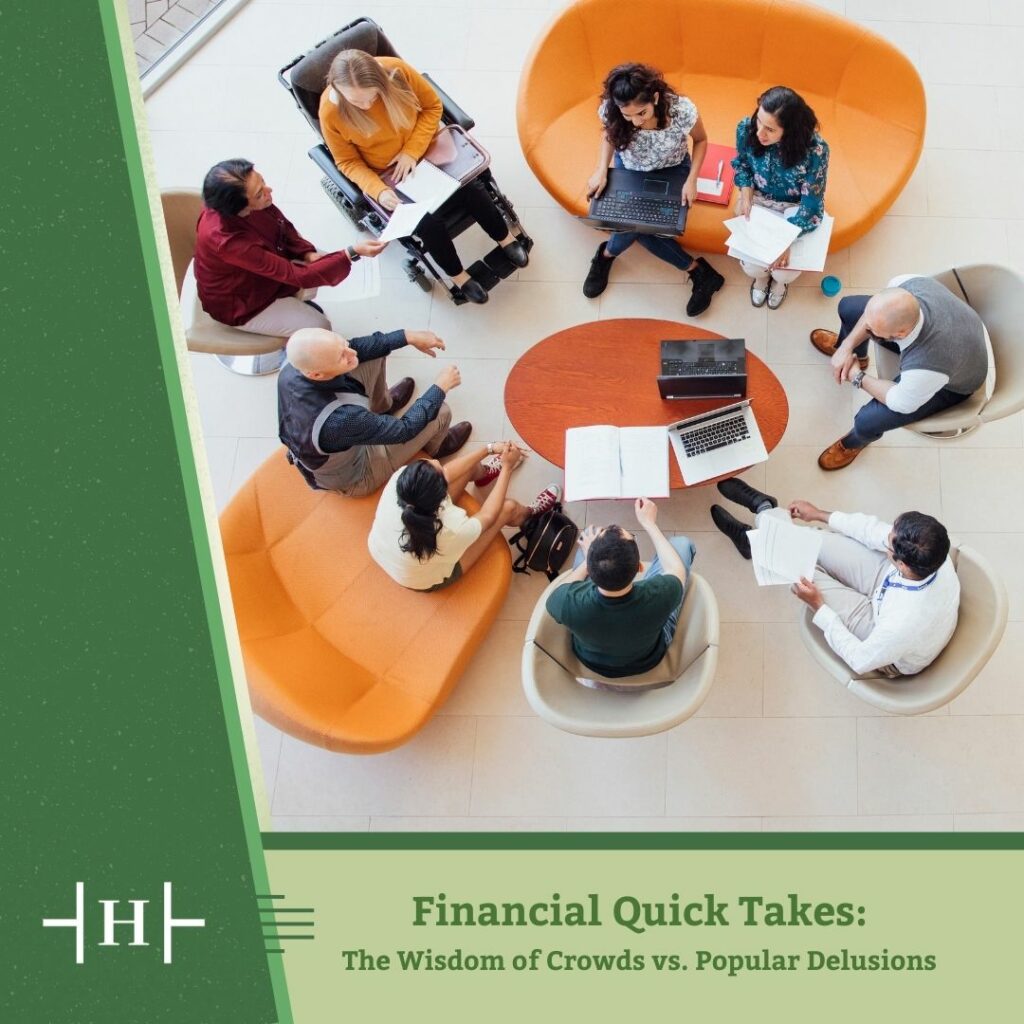
In a bit of a paradox, you’ll find the following two titles on our recommended reading list:
- The Wisdom of Crowds, James Surowiecki (2005)
- Memoirs of Extraordinary Popular Delusions and the Madness of Crowds, Charles Mackay (1852)
So, which is it? Are crowds wise or delusional? It helps to understand why the answer is yes, to both, and why both have shaped our investment recommendations through the years.
When Crowds Are Wise
Surowiecki describes group intelligence, or the wisdom of crowds, as follows: “If you ask a large enough group of diverse, independent people to estimate a probability, and then average those estimates, the errors each of them makes will cancel themselves out.”
To illustrate, he shares a classic jelly bean experiment, where a group of 56 students guessed how many jelly beans were in a jar of 850 beans. The group average was strikingly close at 871. Only one individual guess came closer. Similar experiments have been repeated across time and distance, and have found group consensus is consistently among the most reliable counts.
But what about those “mad” crowds? Surowiecki does not suggest every group consensus produces remarkably accurate answers. The group must be diverse, possess “a particular kind of decentralization,” and, importantly, be free to think independently.
Fortunately, these characteristics usually exist in free markets. Each individual trade may be spot on or wildly off, but their average, representing all known information and lucky guesses alike, typically generates our closest estimate to a perfect price in an imperfect world.
When Crowds Are Delusional
Of course, history is also jam-packed with times when crowds have gone bonkers, stampeding toward outcomes no rational individual would choose.
Usually, a crowd’s rash behavior is a result of “groupthink,” or herd thinking. Surowiecki warned against this when he wrote: “Deliberation in a groupthink setting has the disturbing effect not of opening people’s minds but of closing them.”
Investors are exposed to the madness of crowds whenever a stock, bond, or any other tradeable asset goes on an overwrought run or perilous plummet. When fear of missing out (FOMO), or just plain fear overcomes a market’s usual efficiencies, a few lucky souls may profit wildly. But billionaire businessman Warren Buffett describes the most likely eventual outcome: “[T]he stock market serves as a relocation center at which money is moved from the active to the patient.”
Manic pricing is nothing new. When Mackay published Extraordinary Popular Delusions in 1852, he dissected several centuries-old speculative runs, including a 17th century “tulipomania,” when some tulip bulb trades were fetching values normally reserved for entire estates.
Until, abruptly, they weren’t. As Mackay wrote: “Enterprise, like Icarus, had soared too high, and melted the wax of her wings; like Icarus, she had fallen into a sea, and learned, while floundering in its waves, that her proper element was the solid ground.”
Crazy or Crafty?
Thanks to Mackay, Surowiecki, and many others, we know that group dynamics can yield magnificently wise as well as woefully foolish results. We also know that investor “crowds”— capital markets—can exhibit both conditions, depending on the factors at play.
Adding to the challenge, we usually only know in hindsight which type of pricing we are participating in. Predominantly, global markets provide the volume and diverse independence needed to generate highly efficient trades. But from tulipomania to the latest hot holdings, groupthink can blur the view by sending securities off their proverbial rails, for years at a stretch.
Is it a bubble or substantial growth? Only time will tell.
What’s a Rational Investor To Do?
For your own investments, how do you apply the wisdom of crowds and avoid its madness? Whether you try to outpace a wise market or a delusional one, you’re far more likely to be beaten by the crowd than to outsmart it. Under these circumstances, your best bet is to:
Join the wise crowds: Invest as cost-effectively as possible in the market’s broad expected returns, according to your personal goals and risk tolerances.
Rise above the mania: In case market mania is the principal driver of a run, avoid trying to chase or flee individual securities, or time your entry into and out of hot and cold markets.
Would you like to know more? Reach out to us today for a personalized conversation about your investment portfolio.




